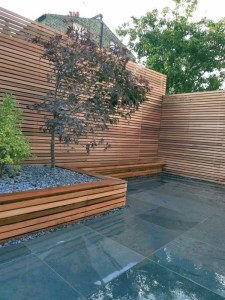It has been a rainy summer in Ottawa this year. Your fence might have taken a toll. To undo the damage, we have prepared a step-by-step guide below. This guide follows a simple 5 steps:
- Check the damage
- Determine the size of the damage
- Clean the fence
- Replace or repair the fence
- Paint or stain the fence
1. Check the damage
Use a pry bar to check the areas of your fence which are broken. In case there are nails fixed to the wooden posts of your fence, use a pair of pliers to remove them. You need to always wear a pair of work gloves when you are mending a fence which was broken in bad weather.
2. Determine the size of the damage
Measure the broken sections of the fence by using a tape measure. Buy a new supply of wood to replace the broken pieces from the fence. Try to purchase wood that matches the one from your fence as much as possible. Measure the wooden post of the fence and use a rip saw to cut the wood to fit the measurements of your damaged fence.
3. Clean the fence
Remove the surface layer of aged wood can bring a new life to your fence. With a power washer, clean your fence. A power washer that operates at 1,500 or 2,000 psi max. Use 15- and 25-degree spray tips. The power washer’s spray will slightly raise and roughen the grain on smooth wood. This allows more sealer to soak in and improves the finish. The wood’s color will brighten as the surface is stripped away. Watch closely and stop stripping when no more color change occurs. You don’t have to remove too much surface to expose fresh wood, and continuing to spray won’t improve the color.
4. Replace or repair the fence
With the fence clean, it’s time to fix or replace damaged boards, refasten loose boards and countersink any protruding nails. Remove the damaged wooden posts and replace them with the new posts by installing them properly in the gap where the broken posts were once located. Place a level on the new post of the fence to make sure that it is straight. Use a hammer and nails to fix the posts to the frame of the fence. Make sure to hammer down the nails in even spaces between one another so that the new post is firmly fixed to the fence’s frame.
5. Paint or stain the fence
Before applying the stain, be sure the fence is dry. Allow at least 24 hours. If it’s cool and humid, allow another 24 hours. Apply paint to the surface of your wooden fence. Make sure that you using exterior paint of a very good quality to paint the fence. Let the exterior paint dry thoroughly after you finish painting and follow the manufacturer’s instructions carefully. Painting the fence is optional but it is a very good idea because it conceals the storm damage repair. To preserve the natural color of the wood, use an exterior semitransparent oil stain. It seals the wood while allowing the grain and color variations to show through. And its pigments add an overall color tone. Make sure the stain contains ultraviolet inhibitors, which will slow down bleaching by sunlight, and a mildewcide to slow fungal growth. Look for samples on cedar at the paint store, or bring in your own piece of wood to test. A test sample is the best way to ensure a satisfactory result. Most semitransparent oil stains are guaranteed to last two to five years. (Solid-color stains last longer but are more difficult to renew.) Fences usually face severe weathering, so expect the finish to last no more than three years. Plan on recoating the fence within this time frame to keep your fence looking fresh. Before recoating, wash the fence with a garden hose sprayer and use a bristle brush on stubborn dirt deposits and stains. Let the fence dry and stain it using the same method.


